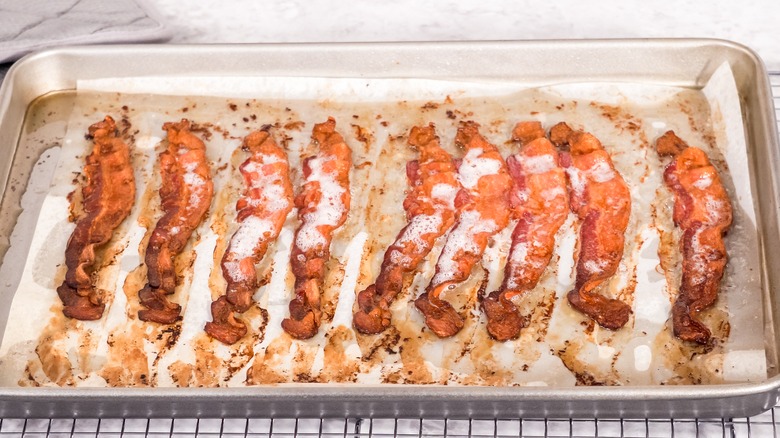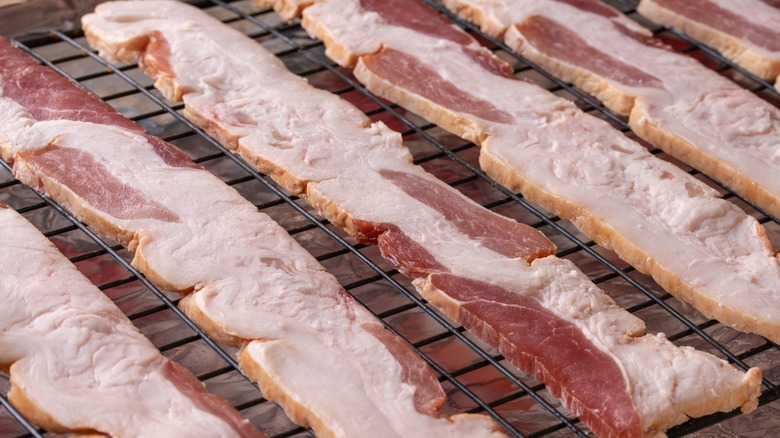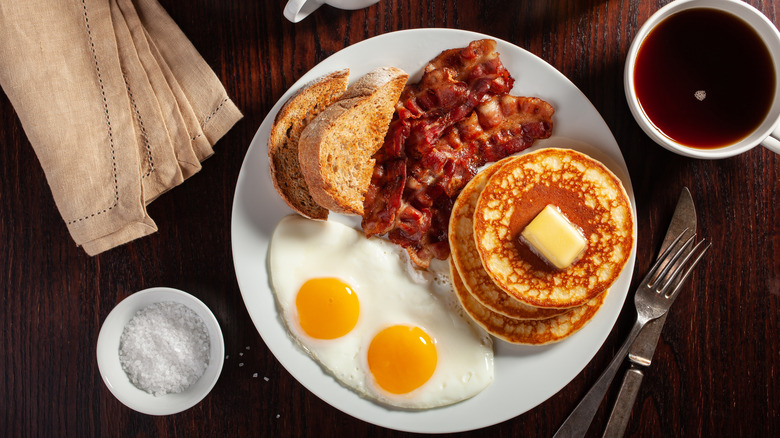What Temperature Should You Cook Bacon At In The Oven?
Pan-cooked bacon? Messy, inconsistently chewy, annoying. Oven-baked bacon? Perfect every time, superior texture, no babysitting required. It's clear as to why baking is almost always the better choice for cooking bacon, but in order to get the most out of the method, you need to cook it at the right temperature — or you might wind up with floppy or burnt bacon anyhow. Depending on your oven, about 400 degrees Fahrenheit is a good place to be.
The amount of time you need to cook bacon will depend on the thickness of it and the specifics of your oven, but about 15 to 20 minutes is typical. Stick to a shorter cook time if you want to batch-cook bacon that will then be reheated for meals throughout the week, and turn up the minutes if you are making very thickly-cut bacon. If you like your slices on the crispy side, check them often after the 15-minute mark, so that they do not accidentally burn.
While 400 degrees Fahrenheit is a good middle ground, feel free to adjust the heat according to your preferences. Those who like their bacon shatteringly crisp and slightly charred can stay around the 425 degrees Fahrenheit point, while others who like a softer texture can drop the temperature down to closer to 375 degrees Fahrenheit and cook for a few minutes longer.
Tips for baking bacon
The most important tool for cooking bacon in the oven is a sheet pan, and it has to have high sides. A rim measuring at least half an inch high is key for catching all of that melted fat. Also, one of the mistakes everyone makes when cooking bacon is forgetting to line the baking sheet. It allows you to easily funnel bacon grease out of the pan to save for later, makes clean-up a breeze, and it actually helps the bacon cook more evenly.
As for lining the pan, aluminum foil and parchment paper both work for cooking bacon. However, thinner slices that are prone to sticking are better off with a parchment paper liner, since it is actually non-stick. Ina Garten makes her breakfast bacon using a wire rack-lined baking sheet instead, which yields extra crispy strips. The major drawback is having to clean grease off the surface, but go for it if the crunch factor is a priority for you.
Also, a cold oven may be key for perfecting your bacon — as the oven warms up, the fat slowly renders out. Then, the bacon finishes frying in that rendered fat, resulting in a perfectly-cooked slice. Some people swear by this technique, while others prefer to preheat the oven before popping the bacon in. Since everyone's perfect slice is personal, feel free to play around with all of these factors to figure out what works best for your preferred style.
The best ways to use oven-cooked bacon
A huge benefit of bacon that has been baked is that it cooks up pretty much flat. That means it is perfect for BLT or club sandwiches where you want the bacon to leave enough space for all the other ingredients (a wavy shape can also cause structural issues, making for a messy sandwich). Flatter bacon works well as a topping on burgers, sliders, and breakfast sandwiches, and compared to curled-up bacon, it is also much easier to chop evenly for salads, pastas, scrambled eggs, and bits for loaded mashed potatoes.
The flat shape also lends itself well to stashing in containers for your weekly meal prep, as it lays more neatly. If you would like, you can even use this double sheet pan hack to prevent your bacon from curling at all. The other big draw of cooking bacon in the oven instead of the stovetop is that lets you multitask, especially since you do not need to flip it. If you are hosting a brunch party or trying to feed a large group of people, you can stick a pan into the oven, set a timer, and get to brewing coffee, pouring mimosas, and flipping pancakes.



